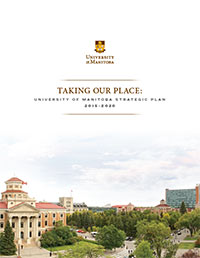to Indigenous achievement

Manitoba has a large and growing Indigenous population. This population is younger and growing at a faster rate than the non-Indigenous Canadian population. In fact, it is predicted based on Statistics Canada census data that Indigenous peoples will comprise nearly 19 per cent of Manitoba's population by 2026. The success of First Nations, Métis and Inuit peoples and communities is vital to the health and well-being of our province and, indeed, our nation.
By incorporating Indigenous perspectives into our learning, discovery and engagement programs, the University will help to transform the lives of both Indigenous and non-Indigenous peoples and communities, and make Manitoba and Canada a better place to live. Through the sharing of Indigenous knowledge, cultures and traditions across our campuses, we will build a stronger foundation for students, staff and the wider community.
We are committed to fostering the development of the next generation of Indigenous leaders by providing an inclusive and supportive learning environment that promotes Indigenous student success from the time of admission through graduation and beyond. As Manitoba's research university, we are dedicated to advancing Indigenous research and scholarship, becoming a centre of excellence for this work. In addition, we seek to play a greater role in reaching out to First Nations, Métis and Inuit K-12 students to better support academic success, building a more prosperous and fulfilling future through post-secondary studies for Indigenous families, communities, Manitoba and the rest of Canada. In all our activities, the University acknowledges the need to work respectfully and collaboratively in partnership with First Nations, Métis and Inuit communities.
|

|

|
- Foster a greater understanding of Indigenous knowledge, cultures and traditions among students, faculty and staff.
|
- Widen opportunities for students, faculty and staff to learn about Indigenous perspectives (e.g., through courses/new curricula, service-learning, research projects, workshops, lectures, events, etc.).
|
- Build a culturally rich, safe and supportive learning and work environment in which an increasing number of Indigenous students, faculty and staff succeed.
|
- Increase undergraduate and graduate Indigenous enrolment as a percentage of the total student population.
- Increase first to second year retention rates and graduation rates for Indigenous students.
- Close the gap between Indigenous and non-Indigenous students in retention and graduation rates.
|
- Foster K-12 Indigenous student participation in post-secondary education.
|
- Increase community outreach and engagement activities that build Indigenous student interest in and preparedness for post-secondary studies.
- Establish new and further develop existing pre-university programming and activities for Indigenous youth.
- Explore collaborative opportunities with the K-12 system.
|
- Enhance the University's research capacity on issues of importance to Indigenous peoples and populations.
|
- Lead the further development of the National Centre for Research on Truth and Reconciliation.
|
- Strengthen global connections with Indigenous peoples and programming around the world.
|
- Increase the number of Indigenous faculty and students engaged internationally in Indigenous scholars networks.
- Expand service-learning and community-based research opportunities with global Indigenous communities.
|
- Celebrate achievements by Indigenous faculty, staff, students, alumni and community partners.
|
- Establish an Indigenous leader awards program to recognize and celebrate Indigenous achievement.
|
- Weave Indigenous knowledge, cultures and traditions into the fabric of our University (people, programming, spaces).
|
- Increase the number of Indigenous faculty and staff as a percentage of the University's employee population.
- Make First Nations, Métis and Inuit arts, cultures, and languages more visible throughout our campuses.
|






